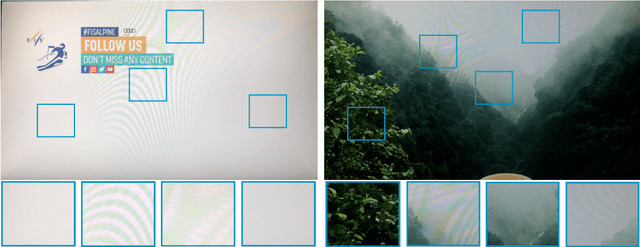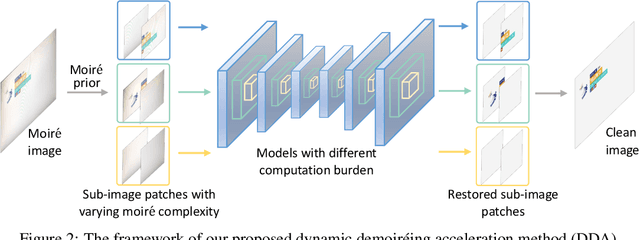Xunchao Li
Real-Time Image Demoireing on Mobile Devices
Feb 04, 2023



Abstract:Moire patterns appear frequently when taking photos of digital screens, drastically degrading the image quality. Despite the advance of CNNs in image demoireing, existing networks are with heavy design, causing redundant computation burden for mobile devices. In this paper, we launch the first study on accelerating demoireing networks and propose a dynamic demoireing acceleration method (DDA) towards a real-time deployment on mobile devices. Our stimulus stems from a simple-yet-universal fact that moire patterns often unbalancedly distribute across an image. Consequently, excessive computation is wasted upon non-moire areas. Therefore, we reallocate computation costs in proportion to the complexity of image patches. In order to achieve this aim, we measure the complexity of an image patch by designing a novel moire prior that considers both colorfulness and frequency information of moire patterns. Then, we restore image patches with higher-complexity using larger networks and the ones with lower-complexity are assigned with smaller networks to relieve the computation burden. At last, we train all networks in a parameter-shared supernet paradigm to avoid additional parameter burden. Extensive experiments on several benchmarks demonstrate the efficacy of our proposed DDA. In addition, the acceleration evaluated on the VIVO X80 Pro smartphone equipped with a chip of Snapdragon 8 Gen 1 shows that our method can drastically reduce the inference time, leading to a real-time image demoireing on mobile devices. Source codes and models are released at https://github.com/zyxxmu/DDA
Dynamic Dual Trainable Bounds for Ultra-low Precision Super-Resolution Networks
Mar 10, 2022



Abstract:Light-weight super-resolution (SR) models have received considerable attention for their serviceability in mobile devices. Many efforts employ network quantization to compress SR models. However, these methods suffer from severe performance degradation when quantizing the SR models to ultra-low precision (e.g., 2-bit and 3-bit) with the low-cost layer-wise quantizer. In this paper, we identify that the performance drop comes from the contradiction between the layer-wise symmetric quantizer and the highly asymmetric activation distribution in SR models. This discrepancy leads to either a waste on the quantization levels or detail loss in reconstructed images. Therefore, we propose a novel activation quantizer, referred to as Dynamic Dual Trainable Bounds (DDTB), to accommodate the asymmetry of the activations. Specifically, DDTB innovates in: 1) A layer-wise quantizer with trainable upper and lower bounds to tackle the highly asymmetric activations. 2) A dynamic gate controller to adaptively adjust the upper and lower bounds at runtime to overcome the drastically varying activation ranges over different samples.To reduce the extra overhead, the dynamic gate controller is quantized to 2-bit and applied to only part of the SR networks according to the introduced dynamic intensity. Extensive experiments demonstrate that our DDTB exhibits significant performance improvements in ultra-low precision. For example, our DDTB achieves a 0.70dB PSNR increase on Urban100 benchmark when quantizing EDSR to 2-bit and scaling up output images to x4. Code is at \url{https://github.com/zysxmu/DDTB}.
 Add to Chrome
Add to Chrome Add to Firefox
Add to Firefox Add to Edge
Add to Edge